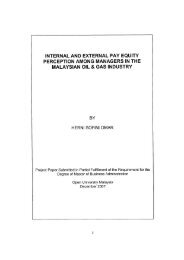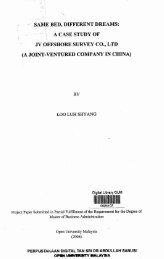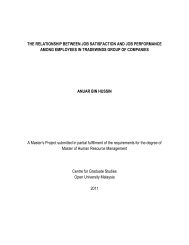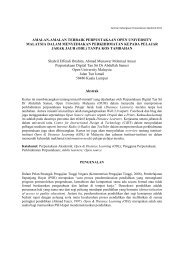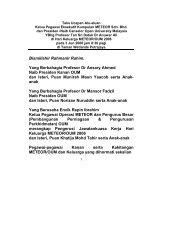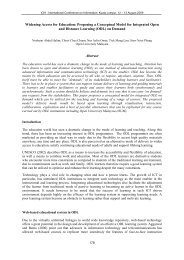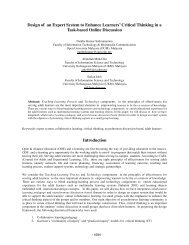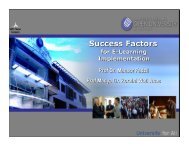Contingent Valuation Method: Valuing Cultural Heritage Chiam ...
Contingent Valuation Method: Valuing Cultural Heritage Chiam ...
Contingent Valuation Method: Valuing Cultural Heritage Chiam ...
You also want an ePaper? Increase the reach of your titles
YUMPU automatically turns print PDFs into web optimized ePapers that Google loves.
Based on Hanley & Spash, (1993); Chan (2009), the CVM is generally divided into six stages. Thesestages are as follows:1. Setting the hypothetical market;2. Obtaining bids;3. Estimating mean willingness-to-pay (WTP) or willingness-to-accept (WTA), or both;4. Estimating bid curves;5. Aggregating the data; and6. Evaluating the CVM exercise5. The Use of CVM To Assess Environmental AmenitiesOne of the earliest practical applications of the contingent valuation method to elicit the market valuationfor nonmarket goods was by Davis (1963) where he estimated the value that hunters and tourists placedon a particular wilderness area. In his study, he found a significant correlation survey result usingestimation on the travel cost method. CVM was even recommended as the assessment when USgovernment agencies were given the power to sue for damage to environmental resources (included nonuse,or existence values) in the 1980s.The importance of valuing nonmarket goods was brought to light with the Exxon Valdez oil spill in PrinceWilliam Sound. Carson et al., (1994) used CVM in a quantitative assessment of damages for the ExxonValdez oil spill in Prince William Sound case. This case used the most carefully developed CVMquestionnaires at that time. Another significant case of CVM application is valuing the preservation ofAustralia’s Kakadu Conservation Zone conducted by Carson et al., (1994). Both of the studies werefunded by their government respectively and both studies also involved a great and in-depth exploring ofthe CVM application on these projects. These studies give a great insight to CVM especially in their stepby-stepapproach and the development of the hypothetical scenarios to represent the assessment ofenvironmental amenities.6. Assumptions Used In CVMThere are several assumptions used in CVM in eliciting the value of non-use goods in the market. It is tobe reminded again that CVM is predicted on a model of an economy comprised of individual decisionmakers who behave rationally in maximizing their own utility taking the considerations of knownconstraints. It is assumed that individuals are the best judges of their own welfare, where each individualcarries equal weight in the aggregation of preferences. CVM works under a well-behaved preferencesystem between goods and the social welfare function contains no arguments other than the welfare ofthe individuals of which society is composed. Generally, CVM accepts that consumers have well-definedpreferences for public goods and that this demand can be measured by the amount of other goods thatthey are prepared to sacrifice to acquire a unit of the good in question.7. Strengths and Limitations of CVMThere are claims that WTP studies can be bias. Biases such as free-riding, the embedding problem,starting-point bias, mixed-good bias etc, can now be effectively controlled for, at least their effects onestimated WTP on the study by Mitchell and Carson (1989). However, the main problem when CVM takeson a specific significance when WTP techniques are applied to cultural goods is the information problem,or in a more precise manner, its converse ignorance. In CVM, it is well-known that the amount ofinformation provided to respondents has a critical effect on their WTP judgments, with well-informedjudgments are better than ill-informed judgments. According to Throsby, (2003) study, in an “ordinary”public good such as national defense or even environmental amenity, it would be able to provide enoughinformation for an informed response to be generated, at least in principle. However, distinguish feature ofcultural goods acquires a taste for them takes time, where they are classed as experiential, their demand



